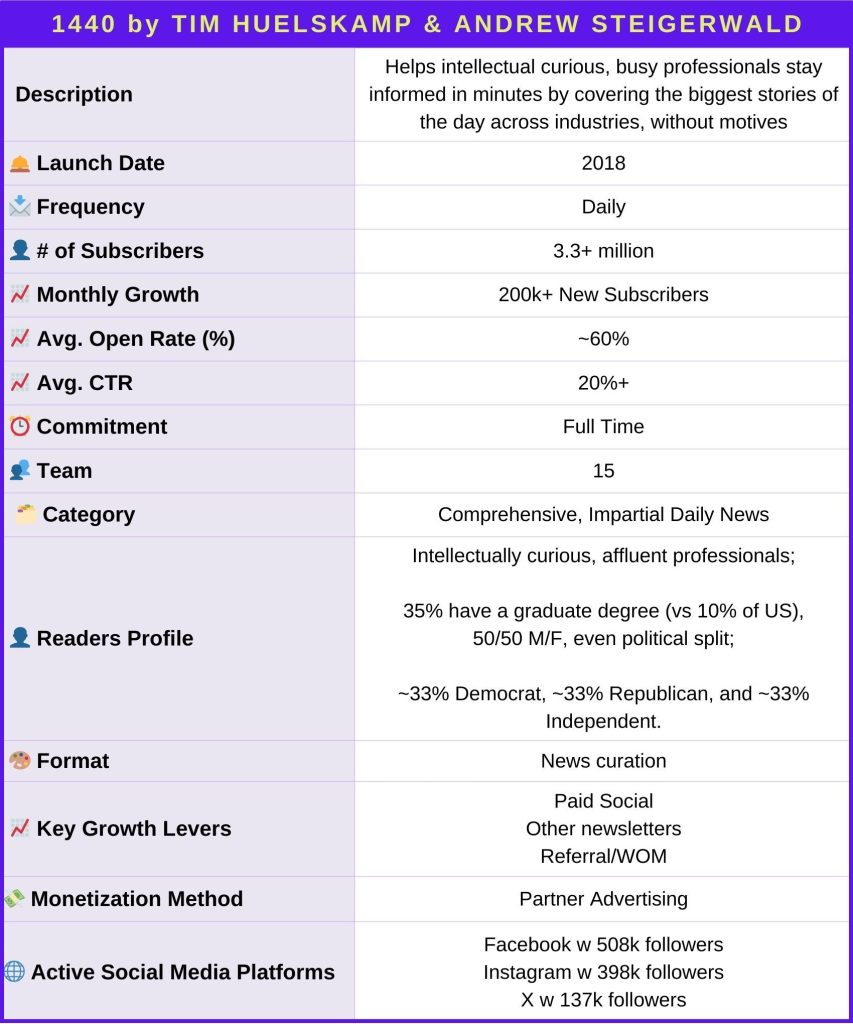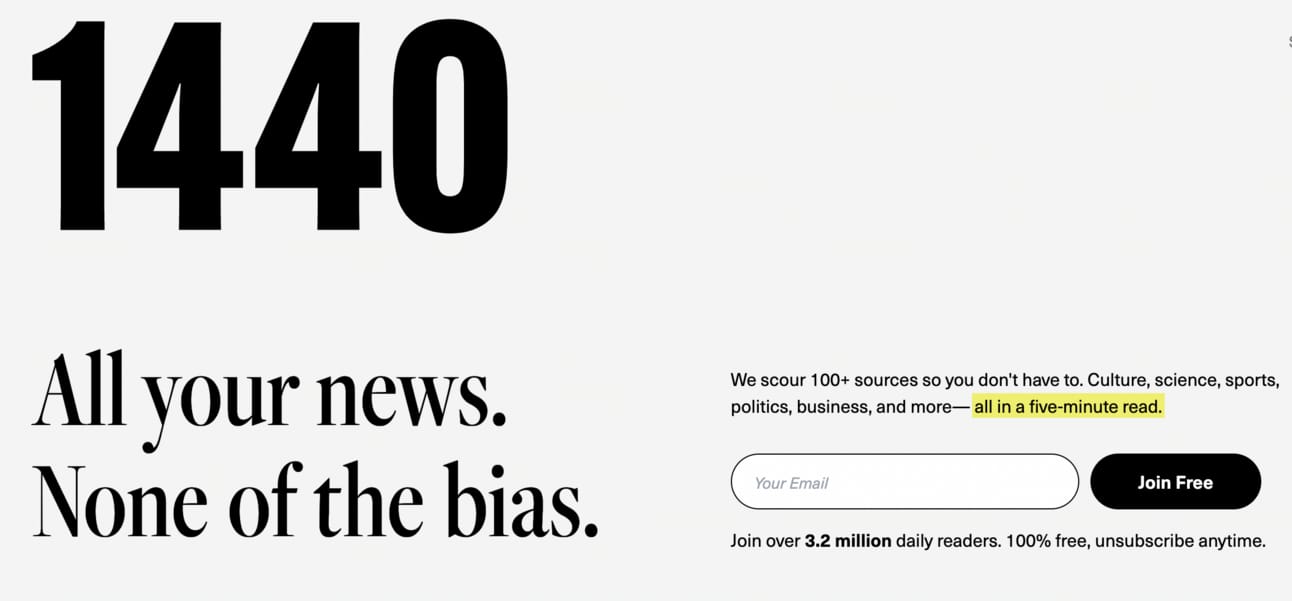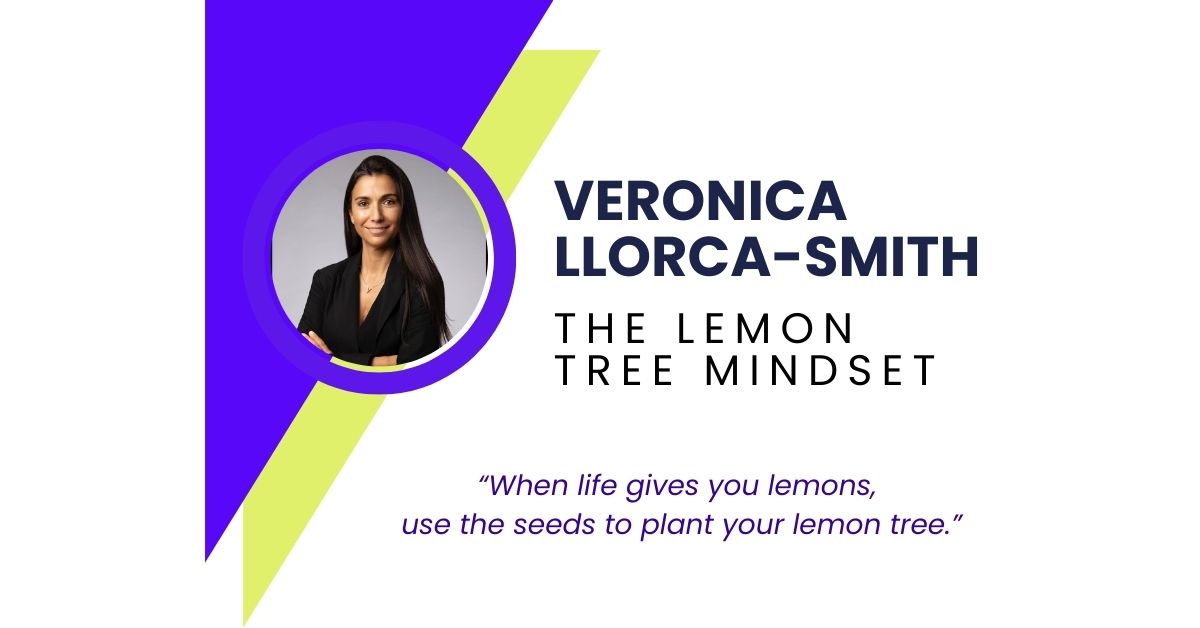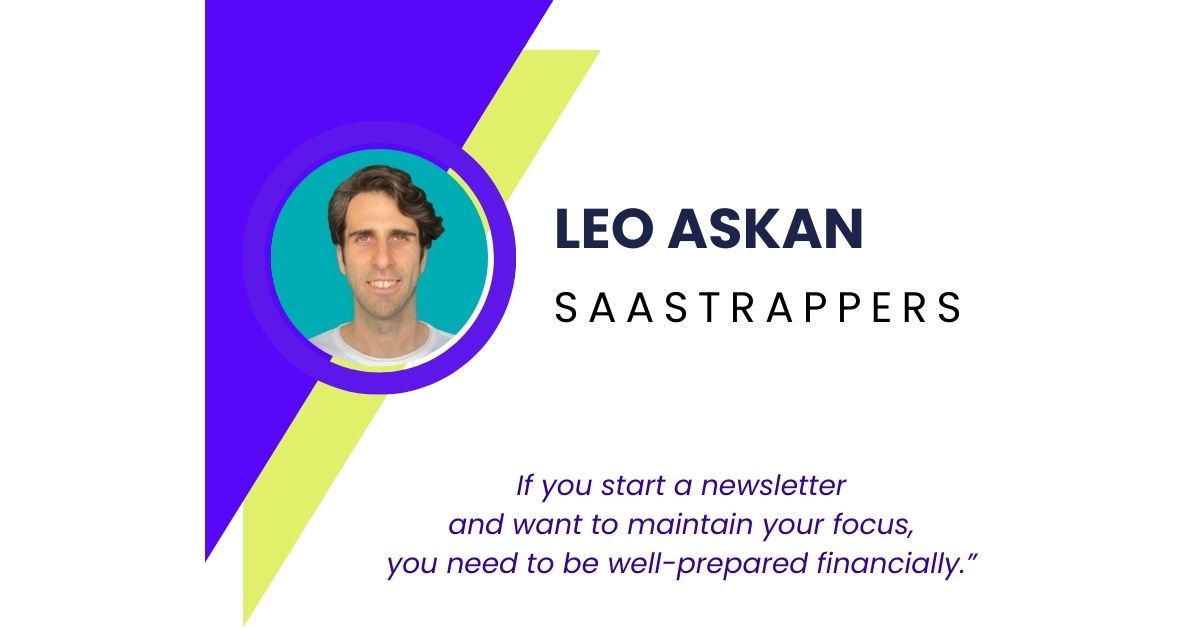Interview Date: February 04, 2024
Table of Content
- Newsletter Identity Card
- Start
- Growth
- Monetization
- Performance Measurement
- Newsletter Experience
- Advice to Aspiring Creators
CREATOR INTERVIEW
1440 is a daily newsletter with over 3.3 million subscribers and a monthly influx of 200K+ new subscribers!
It is named as one of the biggest and fastest-growing digital media startups that ranked No. 79 on the Inc. 5000 list.
And it all started with an issue that they sent to 78 people.
Recently, I had the privilege of meeting Tim Huelskamp, the co-founder and CEO of 1440, on a video call. What struck me most, among many other things, was his down-to-earth approach and his commitment to giving back to the newsletter community. He consistently emphasizes that the success of 1440 is a collective effort, attributing it not only to his dedication but also to his co-founder, Andrew Steigerwald, and the entire 1440 team.
In this interview, you’ll discover:
- How 1440 embarked on its journey, paying attention to critical aspects in the early days.
- Detailed growth strategies on different list sizes.
- Insights into their effective use of paid ads.
- How the monetization strategy of 1440 evolved over time
- How 1440 defines and measures “success”
- What it really takes to build a company to sustainability
- Key learnings, challenges and advice to newsletter creators
- Tim’s favorite newsletters that he looks for every week
I feel incredibly honored to share the behind-the-scenes of 1440 with you.
Join me as we dive into the first part of this enriching journey!
NEWSLETTER IDENTITY CARD

TOOL STACK
- Internal Communication → Slack
- Meetings → Zoom
- Docs & Storage → Google Suite
- E-commerce → Shopify
MEET THE CREATOR
Welcome Tim. Let’s start with getting to know you.
First, I’m incredibly honored to be here – thanks so much for having me! I’m the CEO and co-founder of 1440, a daily newsletter helping ~3.3 million Americans stay informed without motives.
I focus on building our world-class team, customer success, finance, strategy, and assist however else I can help our team succeed (growth, product, sales, etc).
Prior to 1440, I spent nearly a decade at a $20B private equity/venture capital fund, investing in scaling companies and providing operational and strategic assistance to our portfolio companies.
Before PE, I worked in technology Investment Banking at Jefferies right out of college. I graduated from Boston College (studied abroad in Florence, Italy) where I studied finance and history.
I currently reside in Chicago with my better half, Jennifer.
START
1440 is one of the biggest and fastest-growing digital media startups, with 3.3+ million subscribers and over 200K+ new sign-ups each month.
It also ranked No. 79 on this year’s Inc. 5000 list with 5,764% growth in the last three years. (see here)
But it all started with an issue that you sent to 78 people. (see here)
How did you decide to start 1440 in the first place? How did it happen?
We are the core consumers of our product, and 1440 was borne out of our pain as frustrated news consumers.
We felt the media landscape wasn’t delivering in 2 ways for the busy professional.
First, media (by design) is very nichey-y or verticalized: with publications covering sports, culture, tech, politics, science, etc. To be well-informed across all the verticals, it took too much time sifting through 15-20 products.
Why wasn’t there an “inch-deep, mile-wide” offering – in a world of the opposite – that provided info from all the verticals to help make us well-informed, interesting humans.
Second, once we consumed media from popular platforms, we felt they often included opinions or motives like who we should vote for or how we should interpret an event. On social media, we had to sift through misinformation and waste time finding quality information.
It was quite a burden – why couldn’t someone clean all that up and help us learn efficiently?
“So, we set out to “scratch our own itch” and we built 1440, which serves the 1-2 punch of comprehensive, impartial news we were seeking but couldn’t find.”
GROWTH
Which strategies did you use to grow over 3 million subscribers along the different stages of the newsletter?
0 – 1,000 subscribers
We started by sending a minimum viable product (MVP) to 78 friends and family. We ourselves had the pain point, but we wanted to confirm others also craved the service.
We started sending 1440 once per week. We told ourselves if we didn’t see a 40%+ open rate, and a 10% weekly organic growth rate, we would stop.
After week 1, we saw a 60%+ open rate (which we still have today) and our audience of 78 increased to 91. So we kept going.
“In the initial quarters we focused on nothing else but the product.
We begged for feedback (we still do) and iterated on the product as much as possible to deliver for our user: the intellectually curious, busy professional.”
1,000 – 50,000 subscribers
After a few quarters of iterating and growing organically, we thought we had something, so we next focused on “de-risking” the company by working to see if we could grow 1440.
In the early days, we had extremely limited capital, so we focused on newsletter swaps/cross-promos, and we also invested in the giveaways channel via a platform called DojoMojo, which allowed us to drive subs very inexpensively.
We also continued to see organic/WOM/referral growth.
50,000 – 100,000 subscribers
By the time we hit ~50k subs, our audience was large enough to monetize. We started selling ads to brand partners who saw great ROI, and became repeat customers. Given our lean and mean team at the time (and now, still) we were able to generate a small profit and reinvest the revenues into growth (I also pumped a little capital into the business as our quasi-angel investor).
We focused on Facebook ads and started to see success in acquiring users for $1-2.
Organic/WOM growth continued to drive users, as well.
100,000 – 500,000 subscribers
We expanded marketing channels and tested ~dozens of platforms: Google, Reddit, Pinterest, Quora, other newsletters, scaled newsletter channels (e.g. LiveIntent), among others.
This allowed us to diversify our channels away from solely Facebook. At one point, 90% of our paid growth was from Facebook, which presented a concentration risk to the growth org.
Organic/WOM growth continued to drive users, as well.
500,000 subscribers – present
Not much has changed on the sources of acquisition front, as we like to lean into where we see success – and we still see ~30% organic/WOM growth and ~70% paid.
However, we focus on the work required to improve every day at it. Last year, we made an absolutely terrific hire (understatement of the century?) bringing aboard of new head of growth, Erika. She’s incredibly gifted at growth (among other things) and has our team adding 200k+ subscribers per month (January was 300k!+).
While we largely focus on the same channels, she’s brought sophistication to our organization and has us focusing on creative iteration and LPO. Erika partners with numerous creative agencies and focuses on testing quality creative at scale.
“Last quarter, we tested ~1500 (not a typo) creative ads on the various channels.
As the platform algorithms become more sophisticated at targeting, creative is the biggest lever brands can invest in, and we invest in quality creative heavily. “
We also focus on LPO strategies to increase our CVR and reduce CPA.
I would like to elaborate on your paid ads strategy, but first, let’s address the elephant in the room.
During our call, we discussed the tendency among newsletter creators to treat paid ads as if they should be ashamed of using them. Some try to create a perception that organic growth makes their content more valuable. This is something I disagree with. Paid ads are just another way to reach a target audience if you have the resources. In the end, what matters is whether these subscribers are reading and engaging with the content.
What is your evaluation of this approach to using paid ads to grow a newsletter?
Yes, I disagree vehemently (I always wanted to use that word).
“Paid ads for business growth is a fantastic strategy.
While the dream scenario of 100% organic growth through word of mouth is (of course) ideal, the reality is it only happens to a select few companies each year (TikTok, etc).”
For the 99.9% of companies, setting up a strategy where you can acquire users profitably is key.
In the private equity world (where I come from), going through the work of establishing a unit-economics-profitable business model (e.g. figuring out how to turn $1 of invested capital into $5 is) is the end goal.
When do you think it’s the right time to start experimenting with paid ads?
I meet lots of newsletter founders who, in my opinion, focus on scale/growth too early. For this business model to be successful, you need to have a world-class product with a multi-year retention rate of users. If you don’t have that – nothing else matters.
“So for the folks just starting out, I would say don’t even think about paid ads until you have a 45-50% open rate and delight and retain users.
As my favorite VC Marc Andreeseen says: “until you have PMF, nothing else matters.”
Which channel has been the most effective one for 1440 in terms of conversion and acquiring high-quality subscribers?
Highest quality = other newsletters.
Go figure, but folks who already enjoy newsletters tend to open at a rate ~2x of users acquired on paid social. However, without scaled channels (e.g. LiveIntent), buying newsletter placements can be time-burdensome and lack scale. Also, the CPA tends to be ~2x those of paid social.
Best scale = Facebook/Instagram and Google.
Both channels offer near-limitless scale and a reduced CPA, but at lower quality. So it’s a constant battle on where to place budgets to optimize long-term unit economics.
In those key channels, what are the key metrics that you track?
CPA.
“Yes, we review CPM, CTR, CVR, etc as drivers, but at the end of the day, if we’re seeing a high-quality subscriber at a low CPA, that’s all that matters for our business model.”
Note: I do see lots of builders focus purely on low CPA, with no regard for user quality: buyer beware.
What are your biggest learnings about applying paid ads to grow a newsletter?
- Lean into how you’re unique. Most of our ads are around our impartial value prop, in a sea of the opposite on social media.
- “Scratch the itch”. We’ve found most of our successful ads describe the pain our readers feel (the same point Drew & I had when we started 1440). So we use “creative as targeting” to lean into the pain, and then we state how 1440 uniquely solves the problem.
If you had the chance to travel back in time and what would you do differently in terms of growth efforts?
I wish we would have met Erika earlier.
“The co-founders learned a ton experimenting (for which we’re grateful) but I’ve learned to scale companies truly, you need to hire brilliant people and generally “get out of their way”.
Second, early on, we explored various channels – Pinterest, Quora, Reddit, etc.
Looking back, I believe consolidating those efforts into mastery of the scaled channels – Facebook and Google – would have been a more strategic move.
“It boils down to the importance of focus – doing less and diving deeper into the channels that yield significant results.”
MONETIZATION
When and how did you start monetizing 1440? How did your monetization strategy evolve in time?
We started monetizing 1440 when we reached approximately 50k subs.
Per my comments in the growth section, we wanted to “de-risk” the company before focusing on monetization.
“First, we wanted to prove we had a world-class product that would lead to long-term retention rates.
As aforementioned, without the retention of users, this business model breaks down.”
Once we had evidence we were delighting and retaining users, we then focused to see if we could grow the audience.
Once we de-risked/proved we could delight and retain users, and grow the audience, we then focused on monetization.
We looked to other trailblazing newsletters in the space and mimicked their strategies. One of the benefits of this space is you can see all their customers in the daily emails. We started outreach to forge relationships.
When we were smaller (~50k subs), we had many CPA/CPC deals to prove efficacy to our audience. As we scaled the audience, these disappeared and we moved to purely CPM or fixed-price deals.
“One of the interesting tidbits I found fascinating: as we scaled, we were “worth the time” of larger brands. Brands with large budgets can so easily place extra budgets on Facebook and Google, you need to be worth their investment of time and drive strong returns.”
As an example, if you have 50k subs at $50CPM on opens, the placement is ~$1k. This often isn’t worth the time of the larger brands who are seeking to deploy tens of millions of dollars per quarter. So as we increased in size, we became more appealing to larger brands.
We’ve become much more sophisticated as we’ve grown up, but at the end of the day we’re always working to delight our customers, by providing them with strong and consistent returns. It’s incredibly easy for a brand to just push the spend to Zuckerberg, so we have to delight them with strong returns and terrific customer service.
What is key to building successful partnerships based on your experience so far?
“Truly understanding the goals of the customer, and how we can serve them.”
Are they seeking awareness, clicks, conversions?
What is the goal of the partnership and how can we overdeliver to the partner, so they retain them as customers?
We also try to delight them with our customer service and be an asset to them in any way we can – including helping with landing pages, ad copy, etc.
“When our partners succeed, 1440 succeeds.”
PERFORMANCE MEASUREMENT
How do you define success for a newsletter business?
First, are our employees happy, healthy, and engaged? Nothing else matters if we don’t have a world-class, happy team.
Second, are we delighting our readers? Without readers who love our product, the business model breaks down.
Third, are we delivering for our partners?
I could list dozens of supporting data here, but it really boils down to those 3.
To quote Sam Walton, “The most important ingredient of our success: it all boils down to our competition not taking care of their customers, and not taking care of their own people. If you want people who take care of your customers, you have to make sure you’re taking care of your people.”
To build on the above, what are the most critical metrics that you track?
I’d summarize this in 3 buckets.
People
We run employee happiness surveys where everyone scores a handful of key questions on how they’re feeling about life and growth at work. We also track employee retention, we haven’t parted with an employee in 3 years.
Delighting users/growth
- Open, Click and Retention rates = Are we delighting and retaining the user? Is our list growing each week?
- CPA (including CPM, CTR, CVR) = Are we attracting new users efficiently?
- LPO = Is our CVR improving?
Delighting our partners/revenue
Partner rebookings/retention rate, are we growing revenues each month, are we growing CPMs, is our pipeline of new clients growing?
We have a host of other metrics: social growth, finance, etc but we like to keep things simple and it really boils down to the buckets above: build a world-class team, write the best product in the space, and monetize and grow our audience effectively.
NEWSLETTER EXPERIENCE
How did building the 1440 newsletter contribute to your life professionally and personally?
How much time do we have here, Ciler? 🙂
I consider myself a lifelong learner.
One of the most rewarding aspects of being a CEO is the dynamic nature of each day. Every quarter, me and my team are working on new challenges. In the beginning, it was MVP product, initial scale and monetization. Now it’s more team-building, strategy, partnerships, product R&D, scale to tens of millions, etc.
Everyone on our team seeks to grow and wants to be challenged. Our collective journey is an ongoing learning experience, contributing valuable insights to our personal and collective knowledge banks.
We also love we’re able to build a brand that shares knowledge and helps the world be a smarter, more interesting, more fascinating place.
I’m so grateful for the relationships I’ve forged, specifically with my colleagues – we all learn from each other every day.
“Creating an exceptional work environment at 1440 is my top priority, fostering respect for each team member’s time, home life and aspirations.”
It’s mind-blowing to build such a successful media business from scratch. During our previous chat, you mentioned that many people, especially in the beginning, helped you, and now you want to give back. We’ve been observing that some founders lose their way after achieving significant success.
How do you manage to maintain your humble approach and a “giver” mentality, as Adam Grant named it? (see here)
I’ve been amazed throughout my life, by how many people have gone above and beyond to help me grow as a colleague and human. It reminds of of a quote from my favorite book, The Alchemist:
“And, when you want something, all the universe conspires in helping you to achieve it”.
Our newsletter space is incredibly, incredibly collaborative – everyone works to help each other grow personally and professionally.
“I think because, at our core, we’re all folks who love knowledge/insights and want to share it with the world.”
I try to return the favors I received, by helping others however I can.
I end every episode of podcasts with an offer for others to reach out to me directly with any questions (same here: tim@join1440.com – I’ll respond).
If you reply to 1440’s daily email, I read every message and respond to nearly every email.
I’ve learned quite a bit from the folks on the other end of the outreach and built incredible relationships.
“Generally speaking, when you serve others, you receive more in return.“
What is the most challenging part of running a newsletter-led media business and how do you handle it?
The most challenging part of running a newsletter-led media business is hiring the smartest people in the world on your team and keeping them happy.
We hire brilliant employees to work on projects they’re incredibly passionate about. We’ve implemented various measures, including minimizing meetings, establishing clear work/life boundaries, conducting happiness and wellness check-ins, and providing above-market compensation and equity upside.
“Ensuring the happiness of our team is our top priority.
Investing in exceptional individuals and prioritizing their treatment is the highest ROI capital by orders of magnitude.
Delighting the reader is next (per above), but it all starts with talent.”
ADVICE TO ASPIRING CREATORS
What would it be if you had the right to give one piece of advice to aspiring newsletter creators who want to build a successful newsletter business?
Focus on understanding and delighting the user and nothing else.
I meet quite a few founders in the space who ask for monetization and growth strategy guidance but have engagement/open rates which will lead to long-term business failure.
“This is a retention and unit-economics business, and if you don’t delight (and retain) the user, you’re toast.
Figure out how you can deliver to your audience better than anyone else (they have dozens of options), and the rest will fall into place.”
And then once that happens, see the above guidance on building a world-class team.
FAVORITE NEWSLETTERS
What are your favorite newsletters that you can’t wait for the next issue?
- Newsletter Circle – to keep me apprised of the inspiring builders in the newsletter space
- Newsletter Operator by Matt McGarry – the best round-up of what’s happening in the newsletter world
- Lenny’s Newsletter by Lenny Rachitsky – incredible product/growth advice, ex-Airbnb product/growth
- Founders by David Senra – it’s a podcast at heart, but there’s also a newsletter – he summarizes biographies of history’s greatest founders, fascinating content; highly recommend
FINAL WORDS
First, thank you so much for the opportunity to share our team’s story. We’ve worked incredibly hard to get here, and we appreciate this opportunity to pass on what we’ve learned – in hopes of helping others on their journey.
“My final word of advice: Startups are INCREDIBLY hard and require you to take a leap of faith in your mission/vision, which can only be accomplished with an unbelievable amount of grit.“
I came from the private equity world, and had so many advantages in starting off, and there were numerous times when we almost didn’t make it. In fact, we may still not make it if our team doesn’t deliver every day to our readers and partners.
Building a company to sustainability demands far more grit, and time/effort than most anticipate, probably by an order of magnitude if not more.
My brilliant co-founder Drew woke up at 4 am every day before his full-time job for ~2 years (while raising an infant!) to ship our product every day when we had 5,000 subscribers. Do you believe in your vision/product as much as Drew did?
“If you don’t love the work and can’t imagine yourself focusing on the business for a ~decade or more, it may not be for you.
But if it is, it’s a journey unlike anything you’ll undertake.”
If I can help in any way, I’m at tim@join1440.com
Where to find 1440
- Facebook w 508K followers
- Instagram w 398K followers
- X w 137K followers
- Reach out to Tim Huelskamp → tim@join1440.com



